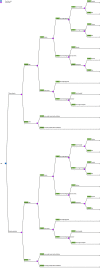Modelling the cost-effectiveness of pulse oximetry in primary care management of acute respiratory infection in rural northern Thailand
- PMID: 36054516
- PMCID: PMC9805201
- DOI: 10.1111/tmi.13812
Modelling the cost-effectiveness of pulse oximetry in primary care management of acute respiratory infection in rural northern Thailand
Abstract
Objectives: We aimed to determine the cost-effectiveness of supplementing standard care with pulse oximetry among children <5 years with acute respiratory infection (ARI) presenting to 32 primary care units in a rural district (total population 241,436) of Chiang Rai province, Thailand, and to assess the economic effects of extending pulse oximetry to older patients with ARI in this setting.
Methods: We performed a model-based cost-effectiveness analysis from a health systems perspective. Decision trees were constructed for three patient categories (children <5 years, children 5-14 years, and adults), with a 1-year time horizon. Model parameters were based on data from 49,958 patients included in a review of acute infection management in the 32 primary care units, published studies, and procurement price lists. Parameters were varied in deterministic sensitivity analyses. Costs were expressed in 2021 US dollars with a willingness-to-pay threshold per DALY averted of $8624.
Results: The annual direct cost of pulse oximetry, associated staff, training, and monitoring was $24,243. It reduced deaths from severe lower respiratory tract infections in children <5 years by 0.19 per 100,000 patients annually. In our population of 14,075 children <5 years, this was equivalent to 2.0 DALYs averted per year. When downstream costs such as those related to hospitalisation and inappropriate antibiotic prescription were considered, pulse oximetry dominated standard care, saving $12,757 annually. This intervention yielded smaller mortality gains in older patients but resulted in further cost savings, primarily by reducing inappropriate antibiotic prescriptions in these age groups. The dominance of the intervention was also demonstrated in all sensitivity analyses.
Conclusions: Pulse oximetry is a life-saving, cost-effective adjunct in ARI primary care management in rural northern Thailand. This finding is likely to be generalisable to neighbouring countries with similar disease epidemiology and health systems.
Keywords: LMIC; Thailand; acute respiratory infection; cost-effectiveness; primary care; pulse oximetry.
© 2022 The Authors Tropical Medicine & International Health Published by John Wiley & Sons Ltd.
Figures


References
-
- Zhang L, Mendoza‐Sassi R, Santos JCH, Lau J. Accuracy of symptoms and signs in predicting hypoxaemia among young children with acute respiratory infection: a meta‐analysis. Int J Tuberc Lung Dis. 2011;15:317–25. - PubMed
-
- Mower WR, Sachs C, Nicklin EL, Baraff LJ. Pulse oximetry as a fifth pediatric vital sign. Pediatrics. 1997;99:681–6. - PubMed
-
- Mower WR, Myers G, Nicklin EL, Kearin KT, Baraff LJ, Sachs C. Pulse oximetry as a fifth vital sign in emergency geriatric assessment. Acad Emerg Med. 1998;5:858–65. - PubMed
-
- World Health Organization . Recommendations for management of common childhood conditions: evidence for technical update of pocket book recommendations: newborn conditions, dysentery, pneumonia, oxygen use and delivery, common causes of fever, severe acute malnutrition and supportive care. Geneva, Switzerland: WHO Press; 2012. - PubMed
Publication types
MeSH terms
Substances
Grants and funding
LinkOut - more resources
Full Text Sources

